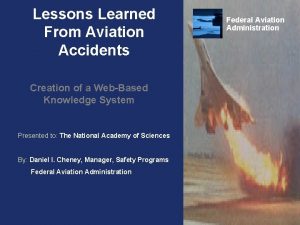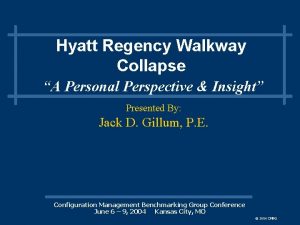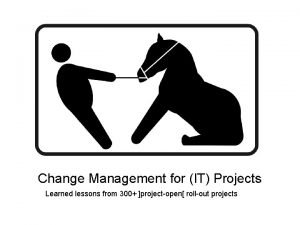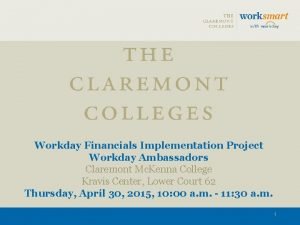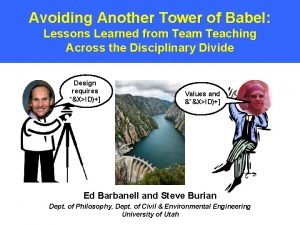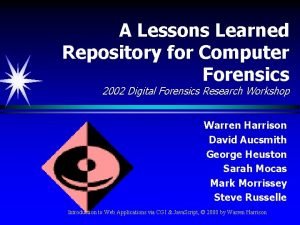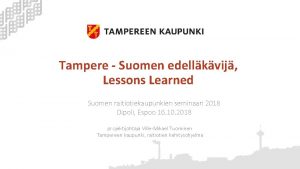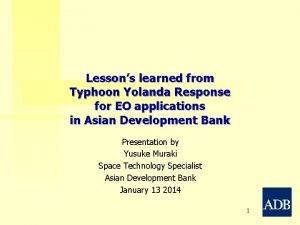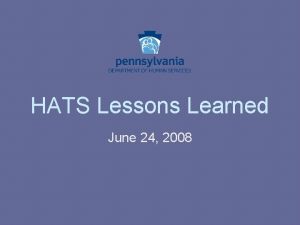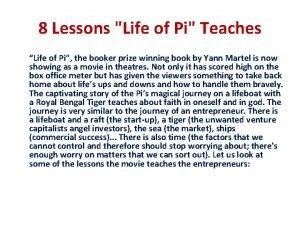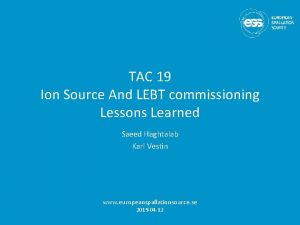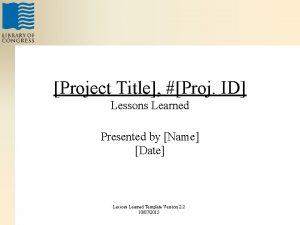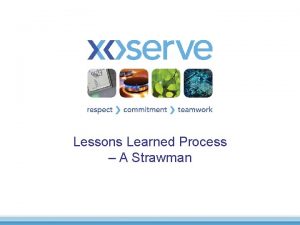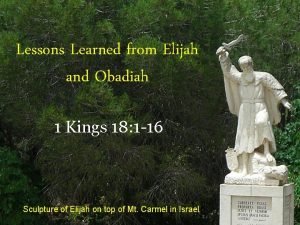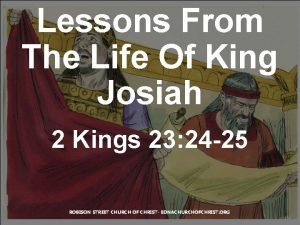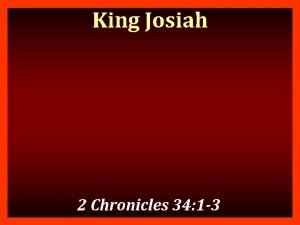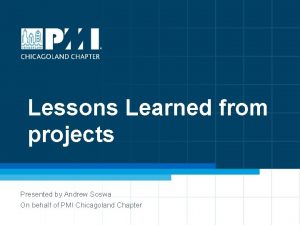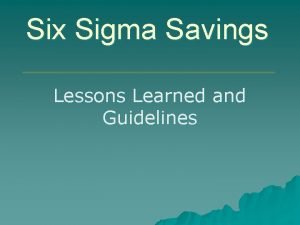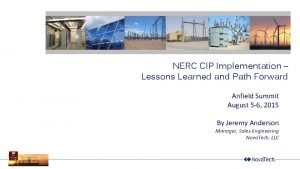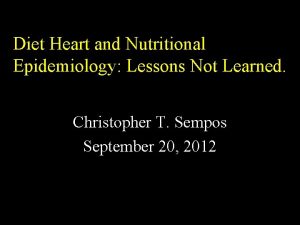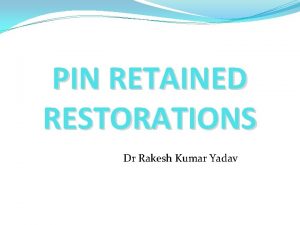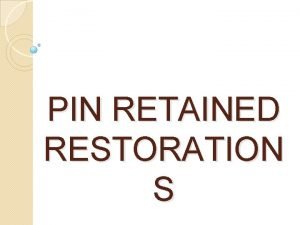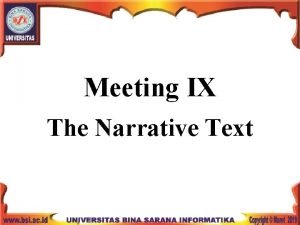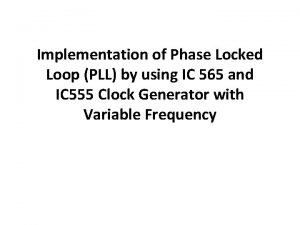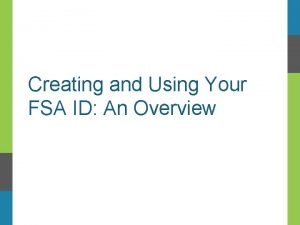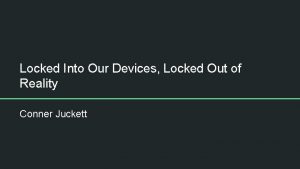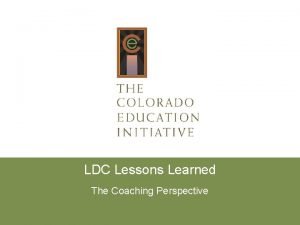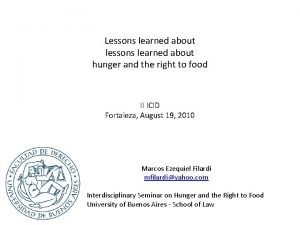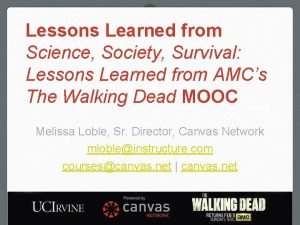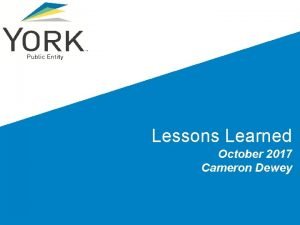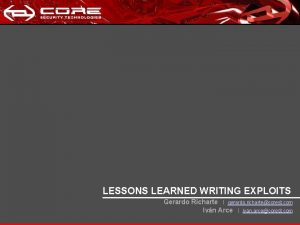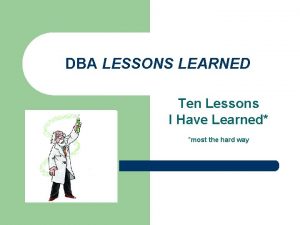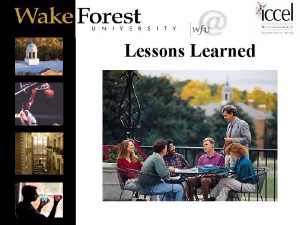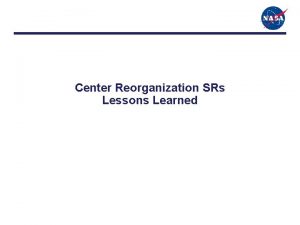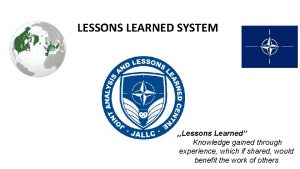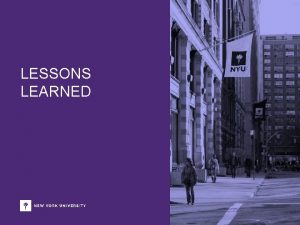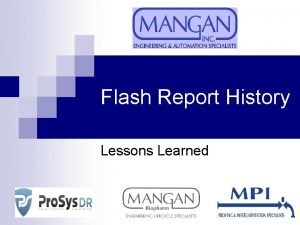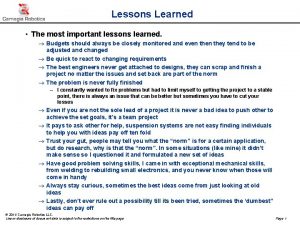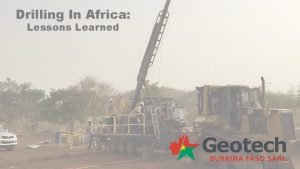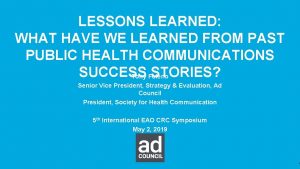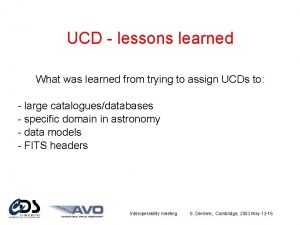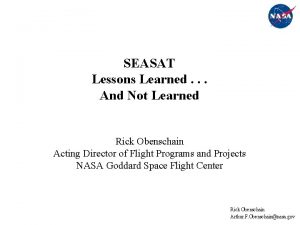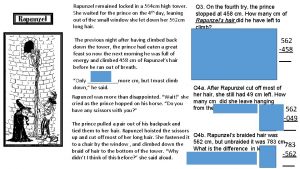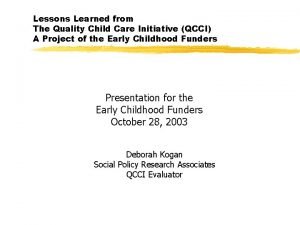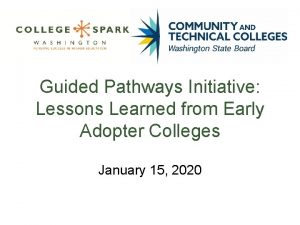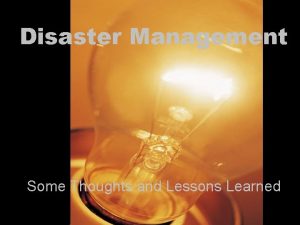U S Lessons Learned Initiative for Locked High



























- Slides: 27

U. S. Lessons Learned Initiative for Locked High Radiation Area Barriers Judd M. Sills, M. S. , CHP Southern California Edison San Clemente, California USA Southern California Edison – San Onofre Nuclear Generating Station Slide # 1 16 March 2006 ISOE International Symposium

Threshold of Concern in U. S. Nuclear Industry The Regulatory Context n Regulatory framework for oversight of the U. S. nuclear industry uses a tiered approach to ensuring plant safety based upon relative risk. n Three key strategic performance areas support the U. S. Nuclear Regulatory Commission’s (NRC) overall safety mission: n n n Reactor safety, Radiation safety and Safeguards Southern California Edison – San Onofre Nuclear Generating Station Slide # 2 16 March 2006 ISOE International Symposium

Reactor Oversight Process Cornerstones Within each strategic performance area are cornerstones the NRC has determined central to plant safety. Satisfactory licensee performance in the each of the three strategic performance areas is essential to satisfying the NRC’s overall safety mission. Southern California Edison – San Onofre Nuclear Generating Station Slide # 3 16 March 2006 ISOE International Symposium

Radiation Safety Cornerstone Southern California Edison – San Onofre Nuclear Generating Station Slide # 4 16 March 2006 ISOE International Symposium

Focal Point of U. S. Reactor Safety Inspection n An important aspect of monitoring licensee performance in terms of occupational radiation safety via this “reactor oversight process” (ROP) is keyed on compliance with regulations for controlling access to high radiation areas and unplanned radiation exposures to workers more than 2 percent of the stochastic regulatory limit, which equates to 100 mrem (1 m. Sv) TEDE. Southern California Edison – San Onofre Nuclear Generating Station Slide # 5 16 March 2006 ISOE International Symposium

Focal Point of U. S. Reactor Safety Inspection n n In terms of occupational radiation protection, a major emphasis of the NRC oversight is focused upon licensee control of high radiation areas. The most visible aspect of a U. S. nuclear power plant’s radiation protection program has become the number and frequency of non-compliance events with 10 CFR 20 or license technical specification requirements for high radiation areas (HRAs). Southern California Edison – San Onofre Nuclear Generating Station Slide # 6 16 March 2006 ISOE International Symposium

Federal Regulations 10 CFR 20. 1601 (a) The licensee shall ensure that each entrance or access point to a high radiation area has one or more of the following features—. . . (3) Entryways that are locked, except during periods when access to the areas is required, with positive control over each individual entry. . (c) A licensee may apply to the Commission for approval of alternative methods for controlling access to high radiation areas. (Emphasis added) Southern California Edison – San Onofre Nuclear Generating Station Slide # 7 16 March 2006 ISOE International Symposium

U. S. NRC High Radiation Area Definition n n NRC defines a High Radiation Area (HRA) as “an area, accessible to individuals, in which radiation levels from radiation sources external to the body could result in an individual receiving a dose equivalent in excess of 0. 1 rem (1 m. Sv) in 1 hour at 30 centimeters from the radiation source. . . ” NRC recognizes requirement to lock all HRAs is unduly burdensome, and statement (c), in 10 CFR 20. 1601 allows the licensee to apply for “alternative means” for controlling HRAs. Southern California Edison – San Onofre Nuclear Generating Station Slide # 8 16 March 2006 ISOE International Symposium

“Alternative Means” – Technical Specification HRAs or LHRAs n n Most U. S. licensees have adopted this “alternative means” provision via their technical specifications, a lengthy licensing document describing required conditions for operation, administrative controls and surveillance requirements. Generally locking of HRAs requirements for locking invoked at a general exposure rate exceeding 1. 0 rem/hour (10 m. Sv/hr). Southern California Edison – San Onofre Nuclear Generating Station Slide # 9 16 March 2006 ISOE International Symposium

NRC Regulatory Guide 8. 38, Control of Access to HRA & VHRAs n Physical barriers (such as chain-link fencing or fabricated walls) may be used to prevent unauthorized personnel access to high and very high radiation areas. Physical barriers surrounding high radiation areas should be sufficient to prevent inadvertent entry (e. g. , a 2 -meter [6 -foot] fence, with worker training and signs or procedures to deter climbing, may be adequate for controlling access to a high radiation area). (Emphasis added) Southern California Edison – San Onofre Nuclear Generating Station Slide # 10 16 March 2006 ISOE International Symposium

NRC Regulatory Guide 8. 38, Control of Access to HRA & VHRAs Physical barriers should, to the extent practicable, completely enclose very high radiation areas (VHRAs) sufficient to thwart* undetected circumvention of the barrier (i. e. , fencing around VHRAs [areas with dose rates greater than 500 rad/hr or 5 Gy/hr] should extend to the overhead and preclude anyone from climbing over the fencing). . Openings in physical barriers around a high radiation area are not required to be controlled as entrances if exceptional measures are needed to access them. (Emphasis added) * Determined circumvention of a physical barrier, with wire cutters or other tools, cannot be prevented absolutely. Such instances should be addressed with appropriate disciplinary action. n Southern California Edison – San Onofre Nuclear Generating Station Slide # 11 16 March 2006 ISOE International Symposium

Implementation Challenged During NRC Licensee Inspections Substantial Material n February 2003, orange colored netting, commonly used as snow fencing along roadways was in use to cocoon LHRAs. n . . . the orange netting used by the licensee was determined to be inadequate because it did not require specialized tools (e. g. , wire cutters) to breach. Specifically, the inspectors determined that the material in question could be easily breached with a pocket knife and thus did not meet NRC guidelines as a “substantial barrier. ” Southern California Edison – San Onofre Nuclear Generating Station Slide # 12 16 March 2006 ISOE International Symposium

Implementation Challenged During NRC Licensee Inspections Intentional Circumvention n October 2003, “noted that the ladder into the area was controlled with a locked sheet metal gate. However, the gate was flanked on the side by rails which were approximately 3 feet [91 cm] high. This would have allowed an individual to bypass the gate by simply stepping over the railing on either side. Therefore, the inspectors concluded that the licensee’s control of the restricted high radiation area was inadequate to prevent unauthorized entry. ” n In this situation, the licensee believed that an 11 meter fall hazard to bypass the barrier negated need for additional barriers. Southern California Edison – San Onofre Nuclear Generating Station Slide # 13 16 March 2006 ISOE International Symposium

Implementation Challenged During NRC Licensee Inspections Decreased Effective Height n August 2004, “The inspectors noted an unattended/unsecured step-stool, approximately two and one-half to three feet [76 – 91 cm] in height, within the corridor associated with the U 2 VCT cubicle. The step stool was easily moved adjacent to the VCT LHRA entrance which consisted of a locked gate approximately six feet [91 cm] in height with an open area between the top of the gate and the ceiling. ” Southern California Edison – San Onofre Nuclear Generating Station Slide # 14 16 March 2006 ISOE International Symposium

Implementation Challenged During NRC Licensee Inspections Gaps n June 2005, “. . . the inspectors identified that the physical barrier (a fence with a locked gate) that was provided to control entry to the Unit 1 reactor coolant drain tank area was not adequate to prevent personnel entry into the area. . the fence did not extend the full length of the annulus region and an approximate 19 -inch [48 cm] wide by 7 -foot [2. 1 m] high opening existed between the outer annulus wall and the fence that allowed physical passage by an individual around the barrier. ” n “. . . the openings were sufficiently large to allow personnel passage around the barrier and into the LHRA with only low to moderate physical effort. “ Southern California Edison – San Onofre Nuclear Generating Station Slide # 15 16 March 2006 ISOE International Symposium

The Issues Discovered During NRC Inspections n n Is the barrier substantial, fabricated of substantial material? Can the barrier be defeated by common hand tools? Does the barrier have any gaps greater than six inches wide? If an LHRA is cocooned to prevent access to LHRA conditions, is it fabricated of substantial material and secured with substantial fasteners, thus requiring more than commonly available hand tools to defeat it? Are there any materials, devices or natural features that decrease the effective height of the LHRA barrier? Southern California Edison – San Onofre Nuclear Generating Station Slide # 16 16 March 2006 ISOE International Symposium

Is the Barrier Substantial, Fabricated of Substantial Material? Southern California Edison – San Onofre Nuclear Generating Station Slide # 17 16 March 2006 ISOE International Symposium

Does the Barrier Have any gaps Greater than Six Inches wide? Southern California Edison – San Onofre Nuclear Generating Station Slide # 18 16 March 2006 ISOE International Symposium

Gaps – The Solution Southern California Edison – San Onofre Nuclear Generating Station Slide # 19 16 March 2006 ISOE International Symposium

If Cocooned, is it Fabricated of Substantial Material & Fasteners? Southern California Edison – San Onofre Nuclear Generating Station Slide # 20 16 March 2006 ISOE International Symposium

Any Features that Decrease Effective Height of Barrier? Southern California Edison – San Onofre Nuclear Generating Station Slide # 21 16 March 2006 ISOE International Symposium

Very High Radiation Areas (VHRAs) Southern California Edison – San Onofre Nuclear Generating Station Slide # 22 16 March 2006 ISOE International Symposium

Harmonization Efforts n U. S. NRC Region III Radiation Protection Manager’s Committee n n n Regional RP Manager’s meeting started in 1989 to exchange best practices and lessons learned Goal - standardize the LHRA posting and barricading practices to the extent practical among the 22 operating reactor units RPM Committee recently spread efforts to promote standardization through the auspices of national Radiation Protection industry organizations (e. g. , NEI, INPO, etc. ) Southern California Edison – San Onofre Nuclear Generating Station Slide # 23 16 March 2006 ISOE International Symposium

Harmonization Focus n The working group determined key attributes critical to a good LHRA program: n Key Control n n Key Issuance n n n Keys only issued to RP Technicians Keys logged in and out Key may not be transferred without logging in first Keys maintained on sealed neck lanyards to avoid loss Double Exit Verification of door/lock (second check by peer) Supervisory Accountability for keys n n n Unique LHRA keys, maintained in locked cabinet, keys under control of RP supervisors only. Keys inventoried weekly Logs verified at end of shift Locking Mechanism – Each lock/key unique Southern California Edison – San Onofre Nuclear Generating Station Slide # 24 16 March 2006 ISOE International Symposium

Emergency LHRA Access n n In the unlikely event of an emergency plant condition requiring immediate reactor operator access to one or several LHRAs, the operations shift supervisor may use an emergency master LHRA key maintained in control room (for valid emergency use only). Appropriate radiological field surveys must be taken by RP or operations personnel upon entry to LHRA. RP technician should assume job coverage responsibilities in LHRA as soon as practical. Southern California Edison – San Onofre Nuclear Generating Station Slide # 25 16 March 2006 ISOE International Symposium

U. S. NRC Efforts to Promote Standardization n A proposed revision to Regulatory Guide 8. 38, “Control of Access to High and Very High Radiation Areas in Nuclear Power Plants, ” was issued for comment by the industry and general public: n Barriers used to control access to high radiation areas should provide reasonable assurance that they secure the area against unauthorized access and cannot be easily circumvented. (That is, an individual who incorrectly assumes, for whatever reason, that he or she is authorized to enter the area, would be unlikely to disregard and/or circumvent the barrier. ) (Emphasis added) Southern California Edison – San Onofre Nuclear Generating Station Slide # 26 16 March 2006 ISOE International Symposium

Closing Comments n n Thank-you very much for your interest. I would be pleased to respond to any questions or comments. Southern California Edison – San Onofre Nuclear Generating Station Slide # 27 16 March 2006 ISOE International Symposium
 Lessons learned faa
Lessons learned faa Hyatt regency walkway
Hyatt regency walkway Change management lessons learned
Change management lessons learned Workday implementation lessons learned
Workday implementation lessons learned Elijah contest at mount carmel
Elijah contest at mount carmel Lessons learned from the tower of babel
Lessons learned from the tower of babel Lessons learned repository
Lessons learned repository Lessons learned suomeksi
Lessons learned suomeksi Typhoon yolanda lessons learned
Typhoon yolanda lessons learned Lessons learned ground rules
Lessons learned ground rules What are the things we can learn from ants?
What are the things we can learn from ants? Life of pi moral lesson
Life of pi moral lesson Tac lessons learned
Tac lessons learned Dps project title
Dps project title Lessons learned purpose
Lessons learned purpose Lessons learned from 1 kings 17
Lessons learned from 1 kings 17 Lessons learned from king josiah
Lessons learned from king josiah 2 chronicles 34:1-3
2 chronicles 34:1-3 Lesson learned register
Lesson learned register Six sigma lessons learned
Six sigma lessons learned Nerc lessons learned
Nerc lessons learned Lessons not learned in blood
Lessons not learned in blood Locked high radiation area
Locked high radiation area Friction locked pins
Friction locked pins Friction locked pin
Friction locked pin The story is about the old witch locked hansel
The story is about the old witch locked hansel Pll circuit diagram
Pll circuit diagram Fsa id locked
Fsa id locked
